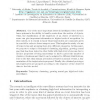Free Online Productivity Tools
i2Speak
i2Symbol
i2OCR
iTex2Img
iWeb2Print
iWeb2Shot
i2Type
iPdf2Split
iPdf2Merge
i2Bopomofo
i2Arabic
i2Style
i2Image
i2PDF
iLatex2Rtf
Sci2ools
219
Voted
IWINAC
2011
Springer
2011
Springer
Clustering of Trajectories in Video Surveillance Using Growing Neural Gas
Abstract. One of the more important issues in intelligent video surveillance systems is the ability to handle events from the motion of objects. Thus, the classification of the trajectory of an object of interest in a scene can give important information to higher levels of recognition. In this context, it is crucial to know what trajectories are commonly given in a model in order to detect suspect ones. This implies the study of a set of trajectories and grouping them into different categories. In this paper, we propose to adapt a bioinspired clustering algorithm, growing neural gas, that has been tested in other fields with high level of success due to its nice properties of being unnecessary to know a priori the number of clusters, robustness and that it can be adapted to different distributions. Due to the fact that human perception is based on atomic events, a segmentation of the trajectories is proposed. Finally, the obtained prototype sub-trajectories are grouped according t...
Artificial Intelligence | Atomic Events | Clustering Algorithm | IWINAC 2011 | Video Surveillance Systems |
| Added | 15 Sep 2011 |
| Updated | 15 Sep 2011 |
| Type | Journal |
| Year | 2011 |
| Where | IWINAC |
| Authors | Javier Acevedo-Rodríguez, Saturnino Maldonado-Bascón, Roberto Javier López-Sastre, Pedro Gil-Jiménez, Antonio Fernández-Caballero |
Comments (0)

